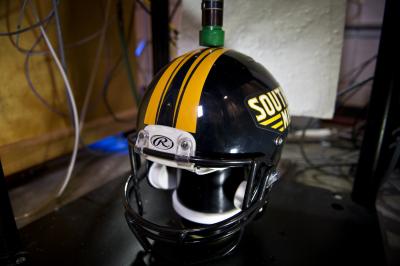Helmet Technology Combines Human Performance and Polymer Science
Tue, 08/05/2014 - 01:30pm | By: Nikki Smith

Researchers at The University of Southern Mississippi have joined forces to create high performance head protection materials, by combining the efforts of the School of Human Performance and Recreation and the School of Polymers and High Performance Materials.
“The biggest thing is that (this approach) provides us the opportunity to have societal influence on a very relevant and pertinent problem,” said Dr. Scott Piland, assistant director of the School of Human Performance and Recreation. “It allows us to demonstrate a collaborative effort across a variety of expertise to be a national leader.”
The challenge he and others on the research team face is developing adequate head protection for athletes to reduce concussions, and other sport injuries. Piland notes that these types of injuries are difficult to clearly diagnose.
“We have the ability now to understand exactly what the protective head gear system is responsible for doing and change the outcome of the injury on the human being,” Piland said. “That way we can actually serve to protect the athletes in the state of Mississippi and even beyond by knowing a little bit more about this injury and how to prevent it.”
Over a decade of work has led to the development of a helmet with temperature-resistant cushioning material that is well represented in high school collegiate and professional sports.
“When the polymer touches the human being, we now have a human – material interface and that is a brand new discipline. It's undiscovered country,” said Dr. Trent Gould, associate dean of College of Health and HPR Professor.
Although head protection technology has come a long way in recent years, researchers at Southern Miss are dedicated to improving and making more discoveries in the years to come by determining when helmets become unsafe after years of use and developing the current technology for military use.
Piland believes that 20 years down the road, with the current stage of 3D printing, researchers may be able to improve the applications to design helmets that are specific to the individual user's needs.
“The major benefit is that our research is multi-disciplinary and covers two schools,” Piland said. “This has created culture of truly wanting to make a societal impact.”
